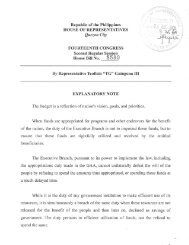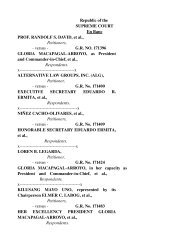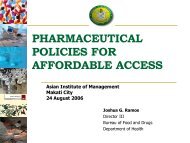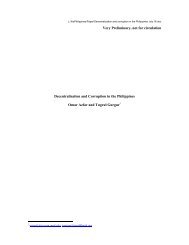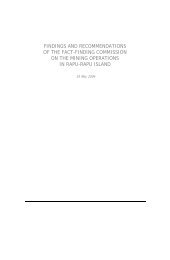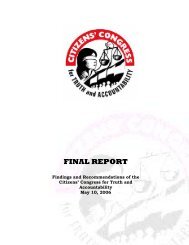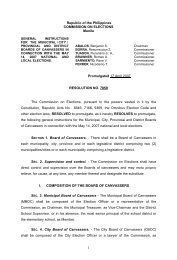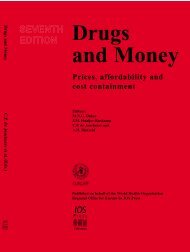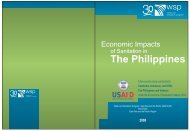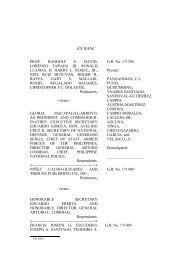The state of water resources in the Philippines - Greenpeace
The state of water resources in the Philippines - Greenpeace
The state of water resources in the Philippines - Greenpeace
Create successful ePaper yourself
Turn your PDF publications into a flip-book with our unique Google optimized e-Paper software.
<strong>The</strong> EMB report on monitor<strong>in</strong>g <strong>of</strong> DO levels shows that approximately 47 percent<br />
<strong>of</strong> 127 <strong>water</strong> bodies are found to have good <strong>water</strong> quality and could be tapped as<br />
sources for <strong>water</strong> supply.<br />
Forty percent recorded fair <strong>water</strong> quality, which means that <strong>the</strong> <strong>water</strong> bodies<br />
partially comply with <strong>the</strong> designated <strong>water</strong> quality criteria but do not support its<br />
<strong>in</strong>tended beneficial use <strong>in</strong> 50 to 97.99 percent <strong>of</strong> sampl<strong>in</strong>g <strong>in</strong>stances.<br />
Thirteen percent, however, showed poor <strong>water</strong> quality. <strong>The</strong>se <strong>in</strong>clude <strong>the</strong> four<br />
rivers <strong>in</strong> NCR – San Juan River, Parañaque River, Navotas-Malabon-Tullahan-<br />
Tenejeros River, and Pasig River; Guadalupe River <strong>in</strong> Region VII; Meycauayan<br />
and Bocaue Rivers <strong>in</strong> Region III; and Calapan River <strong>in</strong> Region IV-B.<br />
Data <strong>in</strong> <strong>the</strong> PEM 2004 issue <strong>state</strong>s, however, that as <strong>of</strong> 2004, 15 rivers<br />
nationwide have dissolved-oxygen at or below zero, <strong>in</strong>dicat<strong>in</strong>g that <strong>the</strong>y are<br />
“dead” dur<strong>in</strong>g <strong>the</strong> dry months. In addition, Environment Secretary Angelo Reyes<br />
also mentioned <strong>in</strong> a published news article early this year (2007) that as many as<br />
50 <strong>of</strong> <strong>the</strong> 421 rivers <strong>in</strong> <strong>the</strong> country can be considered "biologically dead"<br />
(Gaylican, C, PDI, 2007).<br />
Biochemical oxygen demand (BOD)<br />
Biochemical oxygen demand, or BOD, measures <strong>the</strong> amount <strong>of</strong> oxygen<br />
consumed by microorganisms <strong>in</strong> decompos<strong>in</strong>g organic matter <strong>in</strong> stream <strong>water</strong>.<br />
BOD parameter measures <strong>the</strong> organic strength <strong>of</strong> wastes <strong>in</strong> <strong>water</strong>; <strong>the</strong> greater<br />
<strong>the</strong> BOD, <strong>the</strong> greater <strong>the</strong> degree <strong>of</strong> organic pollution.<br />
BOD also directly affects <strong>the</strong> amount <strong>of</strong> dissolved oxygen <strong>in</strong> rivers and streams.<br />
<strong>The</strong> greater <strong>the</strong> BOD, <strong>the</strong> more rapidly oxygen is depleted <strong>in</strong> <strong>the</strong> stream. This<br />
means less oxygen is available to higher forms <strong>of</strong> aquatic life. <strong>The</strong> consequences<br />
<strong>of</strong> high BOD are similar as those for low dissolved oxygen: aquatic organisms<br />
become stressed, suffocate, and die.<br />
National standards for BOD vary from 1 to 15 mg/L based on beneficial <strong>water</strong><br />
usage and classification.<br />
For this parameter, 47 percent <strong>of</strong> <strong>the</strong> 107 <strong>water</strong> bodies with at least four sampl<strong>in</strong>g<br />
events were found to show good <strong>water</strong> quality, 41 percent have fair <strong>water</strong> quality,<br />
while <strong>the</strong> rema<strong>in</strong><strong>in</strong>g 12 percent have poor <strong>water</strong> quality with <strong>the</strong> highest BOD<br />
recorded at <strong>the</strong> downstream section <strong>of</strong> Bulua Creek <strong>in</strong> Region X. Accord<strong>in</strong>g to<br />
<strong>the</strong> report, this <strong>in</strong>dicates high organic discharges from manufactur<strong>in</strong>g facilities,<br />
run<strong>of</strong>f from livestock production, and discharges from households.<br />
<strong>The</strong> EMB Report fur<strong>the</strong>r mentions that <strong>the</strong>re are three rivers that recorded zero<br />
percent compliance <strong>of</strong> all samples with <strong>the</strong> BOD criterion.<br />
GREENPEACE | <strong>The</strong> <strong>state</strong> <strong>of</strong> <strong>water</strong> <strong>in</strong> <strong>the</strong> Philipp<strong>in</strong>es 15



